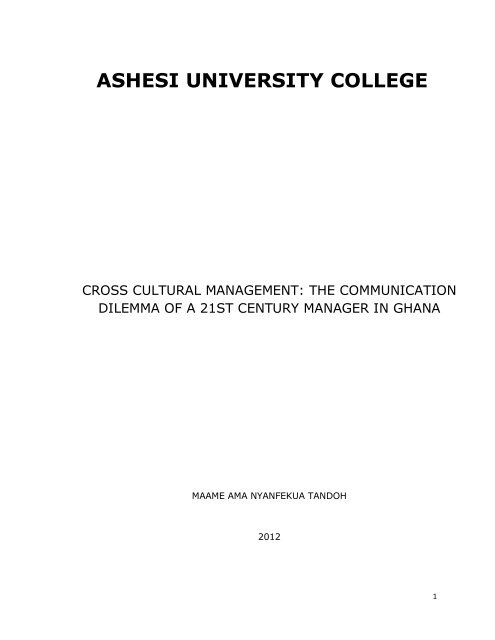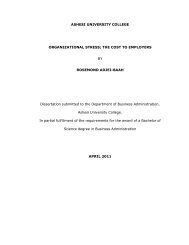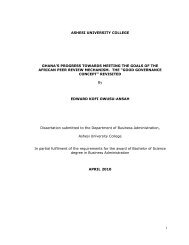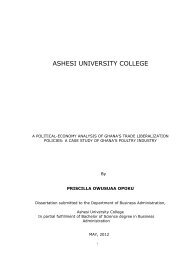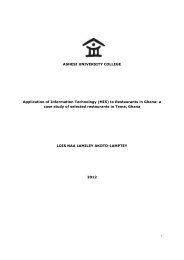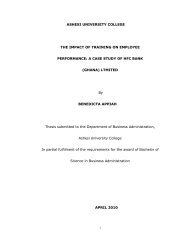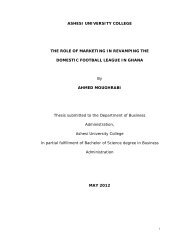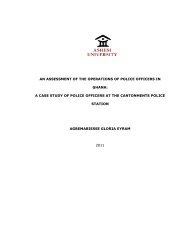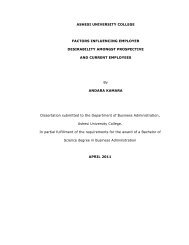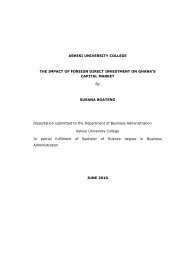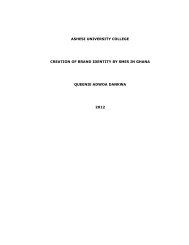ASHESI UNIVERSITY COLLEGE - Ashesi Institutional Repository ...
ASHESI UNIVERSITY COLLEGE - Ashesi Institutional Repository ...
ASHESI UNIVERSITY COLLEGE - Ashesi Institutional Repository ...
Create successful ePaper yourself
Turn your PDF publications into a flip-book with our unique Google optimized e-Paper software.
<strong>ASHESI</strong> <strong>UNIVERSITY</strong> <strong>COLLEGE</strong>CROSS CULTURAL MANAGEMENT: THE COMMUNICATIONDILEMMA OF A 21ST CENTURY MANAGER IN GHANAMAAME AMA NYANFEKUA TANDOH20121
<strong>ASHESI</strong> <strong>UNIVERSITY</strong> <strong>COLLEGE</strong>CROSS CULTURAL MANAGEMENT: THE COMMUNICATION DILEMMAOF A 21ST CENTURY MANAGER IN GHANAByMAAME AMA NYANFEKUA TANDOHDissertation submitted to the Department of Business Administration,<strong>Ashesi</strong> University CollegeIn partial fulfillment of Bachelor of Science degree in BusinessAdministrationMAY 20122
DECLARATIONI hereby declare that this dissertation is the result of my own originalwork and that no part of it has been presented for another degree inthis university or elsewhere.Candidate‟s Signature:................................................................Candidate‟s Name: Maame Ama Nyanfekua TandohDate: May, 2012I hereby declare that the preparation and presentation of thedissertation were supervised in accordance with the guidelines onsupervision of dissertation laid down by <strong>Ashesi</strong> University College.Supervisor‟s Signature:……………………………………………………………………..Supervisor‟s Name: Esi AnsahDate: May, 2012i
AcknowledgementsTo my supervisor Dr. Esi Ansah, I could not have done this without allyour help and support. Not only did you guide me from the initial to the finalstages of this dissertation with tough love yet encouraging smiles, youconstantly inspired me to do better. I am truly grateful to you.To the Chief Officer of Human Resource Management at VodafoneGhana, I appreciate your cooperation and support in gathering the data Ineeded.To Mr. and Mrs. Tandoh, thank you for all the support you gave methroughout the years and all the financial, emotional and moral assistance.This dissertation would not have been possible without the support you gave.I also wish to thank my brother Ato Tandoh for finding time to read mydissertation at the odd times that I sent it to him and giving me helpfulfeedback. To my brother Nana Abakah Tandoh also, thank you for theconstant encouragement. A sister could not ask for more.I wish to thank my friends Serwaa Ofori-Anyinam (my personal alarmclock), Ahmed Moughrabi, and Felix Adams for their support, love andencouragement. To my best friend Efua Kweiba Quaye, “we made it!”Lastly, I want to show appreciation to all my lecturers at <strong>Ashesi</strong> whohave taught me and made me grow over the years. I am who I am todaybecause of them and I am truly grateful.ii
ABSTRACTU.S. and British negotiators found themselves at astandstill when the American company proposed that they"table" particular key points. In the U.S. "tabling a motion"means to not discuss it, while the same phrase in Great Britainmeans to "bring it to the table for discussion." (Kwintessential,2012)Due to the incidence of this mass globalization, there are varyingcultural interactions within several international organisations in Ghana. Theclash of these differing cultures breeds cross-cultural management dilemmaswhich many managers in the 21 st century face.This dissertation identifies five of the most common challenges facedin communication as a result of this dilemma, using Vodafone Ghana as acase study. The study was conducted using surveys and interviews, all basedon the cultural dimensions of Geert Hofstede.Key words: Culture, communication, management, and challenges.iii
ContentsDECLARATION .................................................................................... iAcknowledgements ............................................................................. iiABSTRACT .........................................................................................iiiCHAPTER ONE-INTRODUCTION TO STUDY ........................................ 11.1 Culture ...................................................................................... 41.2 Problem Statement ..................................................................... 51.3 Objective of the Study ................................................................. 71.4 Research question ....................................................................... 71.5 Data Collection ........................................................................... 71.6 Significance of study ................................................................... 81.7 Outline of dissertation ................................................................. 9CHAPTER TWO-LITERATURE REVIEW ............................................. 112.1 National Culture and Cultural Dimensions ..................................... 112.2 Cross-cultural management ........................................................ 162.3 Communication ........................................................................ 182.4 Theoretical framework ............................................................... 20CHAPTER THREE- METHODOLOGY .................................................. 233.1 Research Proposition ................................................................. 233.2 Research Sample and Data Source .............................................. 243.3 Research Design ....................................................................... 253.3.1 Sampling Procedure ............................................................ 263.3.2 Operationalization............................................................... 273.3.3 Instruments ....................................................................... 283.4 Data Collection Procedure .......................................................... 293.5 Data Analysis ........................................................................... 29CHAPTER FOUR- PRESENTATION OF DATA ...................................... 314.1 Demographic Data for the Participants in the Survey ...................... 314.2 Findings .................................................................................. 33CHAPTER FIVE-DISCUSSION, RECOMMENDATIONS & CONCLUSION365.1 Introduction ............................................................................. 365.2 Discussion ............................................................................... 365.2.1 Individualistic vs. Collective.................................................. 385.2.2 Power Distance .................................................................. 425.2.3 Masculinity vs. Femininity .................................................... 455.3 Limitations ............................................................................... 465.4 Recommendations and Conclusions .............................................. 47iv
Bibliography .................................................................................... 50APPENDIX ....................................................................................... 53Table of FiguresTable 1- Demographic data of respondents ............................................................... 32Table 2- Comparison of Employee and Manager Groups ....................................... 32Table 3- Cultural Dimensions from Employee group .............................................. 34Figure 1- Perceptions of Culture .................................................................................... 37Figure 2- Ghana-U.K Comparison of Individualistic Culture ................................. 39Figure 3- Ghana U.K Comparison of Power Distance Culture .............................. 43Figure 4- Ghana- U.K Comparison of Masculinity Culture ..................................... 46v
CHAPTER ONEINTRODUCTION“There are truths on this side of the Pyrenees which are falsehoodson the other.”-translation: Geert HofstedeConsider the story of an American executive who wasdesignated to deliver a formal presentation at a Japaneseconference. During her presentation, the woman becameacutely aware of a man in the audience who proceeded to makestrange faces at her. Following the conclusion of herpresentation, the woman voiced her disapproval to the Japanesehosts. And while an apology was immediately provided, it wasdiscovered that the man in the audience had not intended tooffend the American speaker. He simply became so fixated onher facial gestures that he inadvertently began imitating her.Should this story be considered an isolated incident of a simplemisunderstanding or is this a prime example of everydaymiscommunication between cultures? Many experts wouldsupport the second conclusion (Taking On Tobacco, 2012, p.1).“Although globalization in the twenty-first century has certainlyincreased the ease and scope of cross-cultural interactions at workexponentially, this is clearly an ancient phenomenon” (Gelfand et al, 2007,pg.481). Cultural clashes have been evident for centuries and these crossculturaldilemmas can be dated back to the beginning of civilization around1
Mesopotamia 1in ancient times. From Roman and Persian conquests toconflicts that appeared around the Age of Exploration and Colonialism in the1500s through to the 1800s, cross-cultural clashes can be seen (AlissaKinney, 2011).In a quest to become an industrialized nation with reduceddependency on foreign imports, Ghana has exposed its markets to massglobalization. This is evidenced by the number of international corporationsthat have sprung up and are presently operating in Ghana. Such corporationsinclude MTN, Vodafone, Newmont Gold Ghana, Gold Fields Ghana, EquityAssurance, and Zenith Bank Ghana. The existence of these companies inGhana presents significant benefits both to the development of the nationand also the general progress of the companies themselves.These international corporations undoubtedly foresee a number ofbenefits from expanding their business overseas. These corporations takeadvantage of the need of the country to grow industrially and also exploit therelatively cheap labour that is available. They see the opportunity to breakinto new consumer markets, build new customer loyalty and also use thenew resources within the new market to help expand. When companiesexpand overseas it also creates the opportunity for them to spread the risk ofmarket threats across borders. When a company successfully expandsoverseas, any adverse market conditions such as government overturns or1 “Mesopotamia is considered the first urban civilization, that is to say, it was the first societywhich has provided evidence of people deliberately living in close proximity to one another, withattendant social and economic structures to allow that to occur peaceably.”2
harsh policy implementations in their home countries will not have directeffect on the company overseas (Ellay, 2009).“With a stable political environment and forward-looking investmentclimate, Ghana is prime location for investors, who may wish to tap thecountry‟s abundant natural resources, exploit market opportunities in Ghanaand also within the larger Economic Community of West African States(ECOWAS)” (Ghana High Commission, 2011, pg.1). For seemingly obviousreasons, Ghana is very open to the establishment of foreign companieswithin the country. The 1994 Ghana Investment Promotion Act guaranteedthe freedom for non-Ghanaians to choose potentially profitable areas ofbusiness such as natural gas, hydropower projects, farming of fruits andvegetables, food processing, fish canning, agro-chemical production,pharmaceuticals and information technology and establish and runenterprises in Ghana (Ghana High Commission, 2011, pg.1). These foreigncompanies provide Ghanaians with employment as well as the provision anddevelopment of expert skills and increase in technological know-how.Amidst the vast benefits of international business, there is the need forcultural diversity to be taken into account. When businesses decide toexpand, they hire personnel in the host country and also bring skilled labourfrom their home country sometimes to ensure smooth transition of businessand also as quality assurance. Typically, with such an organisationalstructure of an international company, there is a vast mix of cultures.3
1.1 CultureGeert Hofstede defines culture as “the collective programming of thehuman mind that distinguishes the members of one human group from thoseof another. Culture, in this sense, is a system of collectively held values”(Hofstede,1980/1981). Culture within an organisation also has the samegeneral foundation and degree of influence on the way people act or behave.When the culture of a society is established and identified, any behaviourthat does not conform to the culture of the society is easily spotted and maycause some apprehension. For example, within organisations wherecohesiveness and teamwork are essential, employees who are ultimatelyindividualistic would be found wanting. Cultures differ from society to society.Many have come to accept these differences as they stand apart, howeverwhen these cultural differences are brought together it sometimes provesdifficult to adapt without the proper knowledge and understanding. Though inGhanaian culture it is accepted and sometimes encouraged to give cash giftsand tips for services rendered, in a country like Japan it can be considered aninsult especially if the money is taken directly out of the giver‟s pocket andhanded over (Lynn, 2000). Without proper instruction or education aboutsuch delicate differences, it may cause friction between Ghanaian andJapanese workers, for example, within a company.This dissertation considers the challenges that managers face withregard to communication with different cultures, and the remedies requiredin an attempt to ensure a conducive and effective working environment forall employees.4
1.2 Problem StatementCross-cultural management within a company presents communicationdifficulties, difficulty with alignment with company goals and cultures andalso the need to adapt to the new environment which is accompanied bydifferent work ethics and cultures. Despite the many benefits derived fromthese international corporations and expatriate managers and workers inGhana, there are certain difficulties faced. There is sometimes the problem oflanguage barriers when attempting communication with the lower levelworkers within a company as well as peers of varying cultures. Managersmay also be unfamiliar with cultural practices and etiquette that prevails inthe new environment. Local laws and politics will also take some time to getaccustomed to which also proves to be time consuming and initially rendersthe manager extremely inefficient (Cramer, 2011).An example can be made of an international company in Ghana calledWeatherford. Inadequate communication can cause friction within a companythat can otherwise be avoided. Weatherford is an international oil and gascompany based in Takoradi. Twenty-two Ghanaian workers were locked outof the office premises on the 29 th of November 2011. The workers had beenrequesting salary adjustments and benefits that the expatriate workersenjoy. According to the local-content policy, companies in sectors such as theoil and gas sector must ensure that Ghanaians are actively involved andparticipate in the industry, even though there may still be the need forexpatriate workers. There was clearly inadequate communication betweenmanagement and the Ghanaian workers within the company (MyJoyOnline,2011). The communication issue in this scenario was with the employees‟5
inability to communicate their request effectively to their foreign employers,and also the managers using unfamiliar practices that some may call drasticto get their message across to the employees.It is clear that cross-cultural management presents a challenge for thetwenty-first century manager in Ghana. “Accounting for much of [previousexpatriate managers‟] failure, however, was their inability to adapt to newcultural environments of their host community” (Amoako-Agyei, 2009)Cross-cultural management may occur when;Management of an organisation is situated in a country with differentcultures to the organisation‟s home country. Management wouldtherefore be required to adapt to the prevailing cultures in thatenvironment.Management is of an international organisation such as United Nationsand World Health Organisation.Management is of organisations which employ people from differentcultures, such as IBM and Volvo.All the stated situations cultivate cross-cultural interactions that may leadto the communication dilemma that has been studied. Learning themechanics of operating in foreign or international organisations is not enoughto truly be successful. According to Amoako-Agyei (2009), acquiringknowledge and expertise in a particular field of study is not sufficient toensure success when working with the complex cultures of Ghana, Nigeria orGambia. For managers in Ghana to truly thrive, the sensitive nature of crossculturalcommunication must be addressed.6
The intention of this study was therefore to deduce the communicationdifficulties faced in cross-cultural management amongst culturally diversecompanies in Ghana, using Vodafone Ghana as a case study, and suggestsolutions to these problems.1.3 Objective of the StudyThe purpose of this study was to outline challenges faced due to crossculturalmanagement in terms of communication. It therefore;Identified the top five most common challenges in communication thatarise due to cross-cultural management.1.4 Research Question1. What are the top five most common challenges in communication thatarise due to cross-cultural management in Ghana?1.5 Data CollectionThis study was based on a selected international corporation withinGhana - Vodafone Ghana. This company was chosen based on relevance tothe study and convenience. In order to effectively analyse the effects ofcross-cultural management within Ghana, an organisation such as Vodafonewhich has made efforts in increasing cultural diversity, was a prime case forstudy. Research instruments such as face-to-face interviews were employedas well as structured questionnaires. These questionnaires included closeendedquestions and a few open ended ones.7
1.6 Significance of studyIndustrialization through globalisation appears to be the new frontierin Ghana, enabling growth and development and creating a vast amount ofemployment. Ghana‟s consistent growth rate since the 1980s has laid thefoundation for social stability and international credibility which increases thedesire of foreign investors to invest (Ghana High Commission, 2011). Withan increase in the number of foreign investors and foreign countriesestablishing companies in Ghana, there is also the increase of foreign andtherefore, multi-cultural labour in Ghana also. Although cross-culturaldilemmas are not a new phenomenon and studies have been carried outaround this topic for years, no such study has been done on the effects inGhana. Ghanaians have such a rich and conspicuous culture, that it must beexpected that some communication problems may arise within internationalsettings and corporations having to interact with other cultures.Effective communication is necessary for effective work. With theinflux of foreign labour, it is necessary to deduce the ways in which thechallenges caused by cross-cultural management can be solved or at leastreduced. This study sought to achieve this. The study may also help to guideorganisations to adjust to the cultural differences and take a step towardscombating cross-cultural issues in communication.8
1.7 Outline of dissertationChapter One: IntroductionThis section provides an introduction to the concept of cross-culturalmanagement and the meaning of culture itself. It also highlights the researchproblem and the main objectives of the study. The methods of datacollection, and the manner in which conclusions will be drawn, are alsoprovided in this chapter.Chapter Two: Literature ReviewThis section includes a review of similar work previously done by others,and shall also contain a review various pieces of literature related to thestudy under the following topics:National Culture and Cultural DimensionsCross-Cultural ManagementCommunicationTheoretical FrameworkChapter Three: MethodologyThis section contains research methodology. This chapter focuses onthe data collection process and the various research tools and instrumentsemployed. It also discusses the choice of sample and sample size, statisticaltools and methods of data analysis.9
Chapter Four: Presentation of DataThis section contains a presentation of the data obtained from thestudy and the research findings with regard to the outlined researchobjective. Graphs and tabulations of the data are presented in order to aidanalysis.Chapter Five: Discussion, Recommendations & ConclusionThis section contains conclusions and final recommendations based onthe research findings.10
CHAPTER TWOLITERATURE REVIEWFast paced globalisation and increase in establishment of internationalbusiness increases the need for vast research into the classifications ofculture, the significance of culture and the degree to which, if at all, theinteractions of these varying cultures present challenges of communication inthe corporate world. As a company becomes more international, it becomesnecessary as a manager to increase knowledge and gain betterunderstanding of the various cultural differences that exist in order to takeactions to facilitate the smooth running of business (Lewis, 2011). A numberof similar studies have been carried out in the quest to identify and solvecross-cultural communication challenges that arise within companies.Cultural understanding and the development of cross-cultural relationships isa chief issue in international business. This chapter covers the definition ofculture, communication and cross-cultural management, and its effects onmanagement in Ghana. It will also analyse the degree to which cross-culturalmanagement challenges with communication are and can be experienced.This analysis draws on work done by other writers in the same field of study.2.1 National Culture and Cultural DimensionsAccording to Newman and Nollen (1996), national culture is defined byHofstede as the values, beliefs and assumptions learned in early childhoodthat distinguish one group of people from another. These cultures are11
embedded deeply in the everyday life of individuals and are typicallyimpervious to change (Newman &Nollen, 1996).Cultural transmission is primarily achieved through the process ofsocialisation. Within organisations, socialisation can therefore be defined asthe process by which individuals fit in or become adjusted to new roles andlearn the content of information necessary for adjustment to this new role(Stahl &Caligiuri, 2005 as cited by Payne, 2011). This can also be referred toas training. “Socialisation is therefore essentially a learning process and hasbeen described as an expatriate coping strategy” (Payne, 2011, pg.1). It isthrough this socialisation or training that individuals are taught the sociallyacceptedmanner in which various forms of communication may be carriedout within a specific culture. This is what creates the distinct national cultureof people. Drawing on the works of Hofstede, every nation has a uniquelydistinct culture. When socialisation is carried out in children and they growand also pass this training onto future generations, it becomes fused into thebehaviours and norms of the people in the country. We are all subject to this,based on our upbringing and the environment that we were exposed to.This study realizes the effects of socialization and training on theeffects of culture. In order for differences that are so deeply rooted in thebehaviour and belief systems of individuals to be addressed and worked on,some form of identification and training must be done.There is the belief that various cultures of the world are increasinglyconverging, and this will increase the similarity that exists amongstinternational business practices of various cultures and reduce the occurrenceof any complexities (Leung et al, 2005). This would imply that cultures of12
different nations would begin to cultivate similar communication styles withinorganisations and with regard to international business practices. If this wereto be valid, it would be less necessary for extensive research to be carriedout in order to aid managers in appropriate communication methods. Itwould mean that gradually, domestic standards of communication withinbusiness will become identical to international business standards. Triandis(1994) also states that each cultural group loses some amount of itsdominant characteristics in order to conform. This is a form of adaptation.When people from a certain cultural group add a number of appropriate skillsand characteristics that may be characteristic of another cultural group, itmay be referred to as additive multiculturalism.Another similar perspective argues that culture can be viewed asevolving adaptations to ecological and socio-political influences that a personexperiences in a lifetime and individual psychological characteristics areadaptive to the cultural context within which they find themselves (Leung etal, 2005). Culture can therefore not be viewed as a stagnant concept thatengulfs a group of people. Culture is subject to adaptations according to thecontext within which a person is found.Although this view of converging cultures is in place, Leung et al(2005) continue to say that significant divergence of cultures is alsoincredibly obvious. Hofstede asserts that people possess a kind of mentalprogramming that cannot be altered rapidly, and culture remains consistentover time. This study also believes that culture is such a complexcombination of views and intellect that is collectively accepted, that it is13
difficult presume it can be completely merged with other cultures. Throughinteraction, these distinctions can always be made.Many studies have been done on the differences in national cultureand if these supposed differences have any form of impact on organisationalperformance in terms of communication (Bing, 2011). According to GeertHofstede‟s cultural dimensions, there are five distinct primary dimensionswith which differentiation can be made amongst cultures of differentcountries. These five dimensions provide the degree to which countries varyin diverse ways and aid in making sense of cross-cultural communicationdilemmas that may arise within organisations.The five dimensions generated by Hofstede are Power Distance,Individualism versus Collectivism, Uncertainty Avoidance, Masculinity versusFemininity, and Long-term versus Short-term Orientation. Power Distancerefers to the degree to which the less powerful members of society expectand accept power to be distributed unequally. This essentially deals with themanner in which people relate to one another in a society and how they dealwith inequalities that may be evident (Hofstede, 2001). Individualism versusCollectivism refers to the degree to which people prefer to take care ofthemselves and their immediate family only, as against seeing oneself aspart of a unified society or a group and being loyal to this group. Uncertaintyavoidance has to do with the degree to which people are uncomfortable withambiguity. Societies that demonstrate high uncertainty avoidance wouldtypically be more rigid and structured in affairs compared to a society with alow uncertainty avoidance which would be more relaxed. Masculinity versusFemininity refers to the degree to which the society and the people are more14
aggressive, assertive and goal oriented, against a society and people that aremore cooperative and modest. Long-term orientation refers to the degree towhich societies possess the ability to adapt traditions to changing conditionsas against not possessing the ability to adjust. Societies with short-termorientation are more focused on the short-term and quick results (Hofstede,2001).Hofstede‟s work has been noted as “the beginnings of the foundationthat could help scientific theory building in cross-cultural research” (Sekaran,1983). Though many critiques of Hofstede‟s model have been made, not toomany significant flaws or shortcomings in his research have beenacknowledged apart from disagreements from McSweeney (McSweeney,2002). The work of Hofstede continues to be the largest cross-culturalresearch survey conducted and has generated a vast amount of attentionfrom scholars in recent years especially due to the growing global economy(Sivakumar, 2001).Culture is often known to explain patterns of individual behaviour suchas economic activities, work attitudes, gender roles, and manner ofcommunication and also patterns of groups of people sharing similar traits(Sivakumar, 2001). McSweeney however disagrees with the assumption thatevery nation has a distinct culture with which every individual possess traitsof. It is stated in his research that it is incredibly presumptuous to assumethat each country possess a uniform culture based on the selected IBM 2employees used for the study (McSweeney, 2002). McSweeney also arguesthat the identification of the five dimensions of culture in Hofstede‟s study is2 International Business Machines, a leading US computer manufacturer.15
elusive. He states that the information gathered was situationally specific anddid not provide accurately deductive data on which culture representing thenations can be inferred (McSweeney, 2002).2.2 Cross-cultural managementIf all the various roles and responsibilities of every member of anorganisation were to be laid out and analysed, it would be discovered thatthe most demanding yet rewarding role in an organisation falls to themanagers (Hood, 2008). Hambrick and Mason attempted explaining theextent to which leadership or management, and the decisions made bypersons in those positions, has an effect on the culture of the organisationand eventually help constitute in the overall performance (Hambrick& Mason,1984). Management is defined according to Reh (2011) as the process ofplanning and directing the work of a group of individuals, monitoring andcontrolling their work where necessary. In order for this role of the managerto be effective, communication must also be effective.Studies on cross-cultural management have increased over the yearswith the increase in globalization that has occurred. Growinginternationalization increases the inadequacy of narrow domestic paradigmsof cultural interactions, and reveals the need for broader research into aglobal scope (Adler, 1983). With more and more of the existence of variouscultures within an organisation, there is more of a need to focus oninternational business and the complexities for managers in dealing withthese various cultures with different cultural traits.16
The inability of managers to adjust to the demand of the internationalbusiness environment has been noted as primary cause of internationalbusiness failure (Johnson et al, 2006). Johnson et al (2006) continue to saythat despite the increasing amount of academic research being carried out oncultural issues in international business, firms continue to appear not to bepreparing managers adequately for the diverse international businessenvironment.According to Adler and Bartholomew (1992) as cited by Johnson et al(2006), a globally competent manager is a manager that must:Learn about many foreign cultures, perspectives, technologies andapproaches to conduct business.Be skilful in working with people from many cultures simultaneouslyBe able to adapt to living in other culturesKnow how to interact with foreign colleagues as equalsManagers in international business must fully grasp the need tounderstand the varying modes of communication across nations in order toprevent the occurrence of business faux pas on a global scale. Morrison andConaway (2006) outlined in their book “Kiss, Bow or Shake Hands” thedistinct differences amongst the ways of thinking, manner of conductingbusiness, issues of equality/inequality, and many more aspects of culture ofdifferent nations. These vast differences have a direct relationship oncommunication within the organisation.17
2.3 CommunicationGlobalisation refers to “a growing economic interdependence amongcountries as reflected in the increased cross-border flow of three types ofentities: goods and services, capital, and know-how” (Leung et al, 2005).Leung et al (2005) also state that these inter-relationships on a global scalehave enhanced participation in the world economy and contribute greatly todomestic economic growth and prosperity. The study of cross-culturalcommunication can be referred to as a natural extension of a lesson inlanguage and political science, which examines the challenges faced bymanagers within organisations in dealing with people from different culturalbackgrounds (Johnson et al, 2006). The occurrence of these challenges, dueto the previously mentioned globalisation, will only become more frequent.Effective communication is essential in the attainment oforganisational success. This communication could either be at interpersonal,intergroup, intragroup, organisational or external levels (Wertheim, 2008,pg.1). The process of communication involves the transmission ofinformation from one person or group to another. Any form of distortion orinterference with the delivery of this information can be referred to as noisewithin the process. In the process of communication amongst employees andmanagers within an organisation, this noise can be certain barriers tocommunication such as language used, perceptual biases and culturaldifferences (Wertheim, 2008, pg.2). Wertheim states that in order forcommunication amongst individuals of varying cultures to be effective,deciphering of basic values, motives, aspirations and assumptions must bedone. He also states that the opportunities for miscommunication in cross-18
cultural situations are infinite. It is therefore imperative for the differences tobe studied and understood by managers to ensure that the occurrence ofthese miscommunications are reduced or eradicated.According to Smith (2011), there is evidence which shows thatnational culture of people can be distinguished in terms of the style ofcommunication that prevails. The dispersion of communication styles at thenational level is distinct from the communication styles observed within anation amongst its people (Smith, 2011, pg.216). Gudykunst et al (1996)also state that individualism/collectivism have a direct effect oncommunication. These distinct cultural dimensions have differentcommunication styles based on what they consider valuable or important. Aculture that is primarily masculine for example, would typically carry outaffairs in an aggressive, goal oriented manner and this would ultimatelyaffect communication. Individuals from societies that are known to have aparticularly high power distance would inevitably communicate within anorganisation much differently from individuals who possess the cultureencouraging low power-distance communication. In order to fully grasp thedifferences in communication, it is best to identify the differences in valuesystems and behaviour of different cultures. This suggests that thedimensions of Hofstede would be ideal in order to derive the dispersion ordisparity amongst cultures, and ergo communication styles, of varyingnations that may interact within organisations. It would help to highlight thedifferences between the ways things are done in the different cultures.19
2.4Theoretical frameworkGeert Hofstede carried out comprehensive research on the influence ofculture on individual values in the workplace. The study was conducted usinga large number of IBM employees from seventy different countries (Hofstede,2001). The theoretical framework for this study is based on the theories ofHofstede and the cultural dimensions. The cultural dimensions generated byHofstede are Power Distance, Uncertainty Avoidance, Individualism,Masculinity, and Long-Term Orientation. Hofstede carried out the study togenerate these dimensions by highlighting the differences amongst thevarious cultures in the sample by asking questions dealing with values(Hofstede, 2001). Values, being “broad preferences for one state of affairsover others”, are also said to be mostly unconscious (Hofstede, 2001).For the purpose of this study, the focus was primarily on thedimensions of Individualism/Collectivism, Power Distance andMasculinity/Femininity. The reason for the focus on these three was the beliefthat values necessary to categorize into these specific cultural dimensionscan be readily identified through the choice of communication approach.If an international organisation is established in a country that isbelieved to have a strong collectivist culture, management may choose tohave many of the company activities or tasks assigned to groups rather thanto individuals. In an organisation that would typically comprise bothemployees from the host countries and home countries, this managementtechnique may not favour each group of employees. Behind every decision oraction carried out by a manager are assumptions about human nature andhuman behaviour (McGregor, 2006 as cited by Brown, 2009). The cultural20
dimensions of Hofstede guided the methodology and were the basis uponwhich the study was carried out. The cultural dimensions helped determinethe disparity between value systems and communication conducts of thedifferent cultures in the organisation which helped reveal the communicationchallenges faced. Managers finding themselves faced with cross-culturaldilemmas must understand the complexity of cross-cultural management andaim to provide a mix of cultural value through the organisation.Individualistic and collective cultures can be identified by the mannerin which they choose to communicate. Individualistic cultures may beidentified because of the significance that is placed on the informationalfunction of communication, rather than the relational function (Cross-CulturalCommunication: Individualism vs. Collectivism, 2009). This implies thatindividualistic cultures value the information being transmitted much morethan the prospect of building a relationship. A collectivist culture would placeprecedence on building and maintaining relationships through communicationrather than the message being conveyed.The dimension of Power Distance is essential for the study of crossculturalmanagement because it helps to highlight the major issues withcommunication that can arise between managers and subordinates muchclearly. Cultures with a high power distance tend to restrict communicationbetween boss and employees to formal and professional interactions. Thereis very little room for informality and unnecessary familiarity (Hoftsede,2001). Cultures with a low power distance however, allow for moreinformality and communication between management and subordinates isless rigid.21
Cultures that can be described as Masculine would be aggressive andassertive cultures. This dimension particularly focuses on the manner inwhich communication is carried out, be it aggressively, confrontationally, orpossibly peacefully. Masculine cultures are known to be more assertive, whilefeminine cultures are quite the opposite. Feminine cultures value family andrelationships while masculine cultures value achievement and wealth.Communication in these cultures can therefore either be abrasive and workoriented or calm and compromising (Hoftsede, 2001).22
CHAPTER THREEMETHODOLOGY3.1 Research PropositionThis research was focused on the role of national culture on thesuccess of cross-cultural management in Ghana, and the effects oncommunication. The study was based on Hofstede‟s cultural dimensions ofPower Distance, Masculinity and Individualism. Power distance refers to theextent to which individuals within an organisation expect and accept thatpower is distributed unequally (Hofstede, 1983). This would suggest that theless powerful personnel in the organisation both understand andacknowledge the distance of power from the bottom-up in the organisationor, on the contrary, they acknowledge how very little distance there is inpower from the bottom up in the organisation. Hofstede‟s cultural dimensionof Individualism refers to the degree to which the culture of people is morecollective or individualistic. Some cultures are extremely collective and workwell in strongly cohesive groups, while the ties between individuals in somecultures are significantly weaker (Hofstede, 1983).The cultural dimension ofMasculinity refers to the degree to which a society prefers assertiveness,material award and aggression as opposed to femininity that preferscooperation and modesty (Hofstede, 1983).This research was deductive because data was collected and comparedto these outlined cultural dimensions and their effect on cross-culturalmanagement in Ghana.23
3.2 Research Sample and Data SourceVodafone Ghana was chosen as the case study for this study for thefollowing pertinent reasons:Vodafone Ghana is recognized to have a strong organisational culturethat is comprised of individuals of various different cultures. Thisorganisational culture is dubbed „The Vodafone Way‟. (Vodafone,2011) A company with such a strong organisational culture was idealfor this research as it was easy to identify and set apart from otherunderlying cultures at play within the organisation.The company takes pride in its ability to provide a unique mix ofcultures within its organisation. They are extremely diverse as acompany and they value their diversity and make the most out of it.(Vodafone, 2011) This provided an ideal environment for the researchin order to analyze the interactions of various cultures and the effectsthere of.Vodafone has managed to maintain a successful track record over thepast four years in Ghana and continues to provide satisfactory serviceto its customers. It is argued to be one of the world‟s leadingtelecommunications companies. (Vodafone, 2011) This success may beattributed to the skillful management practices carried out within thecompany across the various locations.24
Vodafone Ghana was also willing to be part of the study and aid in theacquisition of all the necessary information.The sample units employed in the study were employees, both expatriateand returnee workers, and managers within the company.3.3 Research DesignThis study made the use of both quantitative research and qualitativeresearch methods in obtaining information. Qualitative methods were usedwhen non-specific responses were required. Quantitative methods were usedwhen possible responses were provided to the respondents to choose from.Data was collected using questionnaires and interviews. Information fromemployees was obtained using questionnaires. These were the most costeffectiveand time-effective methods of obtaining the needed informationgiven the budget and time constraints of the study. The assurance ofanonymity also helped in ensuring honest and informative answers from theemployees. The individuals that made up the sampling frame are literate andtherefore possessed the ability to effectively fill out the questionnaires.Information was obtained from the managers using interviews. Interviewswere pertinent here in order to discuss the relevant management stylesemployed and also to fully grasp the cultural diversity experienced within theorganisation with information from a more direct interaction with foreignmanagers. Interviews allowed for a more profound analysis.25
3.3.1 Sampling ProcedureInitially, the study was to make use of two-stage cluster sampling inorder to ensure that both the managers and the employees within theorganisation had an equal chance of selection. The managers were to beselected according to relevance to the research. This means that managersthat would not be directly subjected to cross-cultural interaction challengesor do not have any experience on the matter were not to be selected. Themanagers were however selected on the basis of availability, though stillrelevant to the research. The study therefore made use of availabilitysampling in the selection of managers. The case study was carried out at onebranch of the company, which is the Airport branch, where it was believedthere would be a good mix of the expatriate employees, returnee employeesand also the local employees. The research was carried out during workhours of the company in order to increase the probability of finding the bulkof the employees present. The time of the interviews was subject to theavailability of the managers and also their ability to make provision withintheir day for it to be carried out. The questionnaires were in use in order toget as much unbiased information as possible. The sample size was 69,consisting of 59 employees and 10 managers.26
3.3.2 OperationalizationThe main concepts to be discussed as part of the research are:National CultureDefined as: “common patterns of beliefs, assumptions, norms and values ofhuman groups represented by societies, organisations and institutions”(Aycan et al, 2000, pg.3)ManagementDefined as “the activities associated with running a company, such ascontrolling, leading, monitoring, organizing and planning” (BusinessManagement, 2012)CommunicationDefined as “the process of conveying or transmitting a message from oneperson to another through a proper channel” (Education, 2011)CollectivismDefined as “a culture [that] relies on membership in groups - social classes,communities, religions, or extended families - for identity and status. Peopleare protected by the group and are expected to act in the group's bestinterests” (Newman & Nollen, 1996).27
Power DistanceDefined as “the extent to which the less powerful members of organisationsand institutions accept and expect that power is distributed unequally. Thebasic problem involved is the degree of human inequality that underlies thefunctioning of each particular society” (Hofstede, 2001)MasculinityDefined as “a preference in society for achievement, heroism, assertivenessand material reward for success. Society at large is more competitive”(Hofstede, 2012)3.3.3 InstrumentsQuestionnairesThe questionnaire was in three sections.The first section dealt with collecting basic demographic informationsuch as nationality, duration of employment and country in which theireducation was attained.The second section employed Likert scale questions in order to deducethe significant cultural values that govern the behavior of theemployees and the managers. The questions were based on thecultural dimensions being used for this study. Participants were askedto agree or disagree with various statements.The third section dealt with collecting information on the views andimpressions of culture by the employees.28
InterviewsThe interviews with the managers were structured into two main sections.The first section was used to understand the dominant cultural valuesthat the manager possesses, using the five cultural dimensions as abase. This section will also be used to deduce whether the managerencounters and challenges specifically related to the diversity ofcultures within the organisation, some of which may be quite differentfrom his/her own.The second section was to collect basic demographic information suchas nationality, duration of employment and country in which theireducation was attained.3.4 Data Collection ProcedureSurveys were administered to the managers and the employeesindividually.The questionnaires were given to the employees and theinterviews were conducted on the managers. This collection of data was doneduring work hours.3.5 Data AnalysisThe information gathered from the closed-ended questions on thequestionnaires was changed into quantitative information and analyzed todetermine frequencies, distributions and correlations that may exist usingSPSS and Microsoft Excel. The qualitative data retrieved was analyzed usingcontent analysis and thematic analysis where the recurring themes in the29
data collection process were identified. Any existing correlations betweenthese identified themes and the quantitative data retrieved were drawn.30
CHAPTER FOURPRESENTATION OF DATAThe data for the study was obtained from a sample of 59 Vodafoneemployees at the Airport Head Office and 10 managers. The employees weregiven questionnaires to fill, and the managers were interviewed separately.The data collected sought to establish answers to the research questionwhich was- What are the top five most common challenges in communication that arisedue to cross-cultural management in Ghana?The data obtained also sought to address the objective of the study whichwas to- Identify the top five most common challenges in communication that arisedue to cross-cultural management.4.1 Demographic Data for the Participants in the SurveyMost of the respondents had not been working at Vodafone for a largenumber of years. Only 10.2% of the respondents had worked for Vodafonefor more than six years, leaving 89.8% of them working there for betweenless than a year to six years. Majority of the respondents have spent 80% oftheir life in Ghana (approx 89.8%) while some respondents have spent 80%of their life in other countries such as Canada, Cote d‟Ivoire and the UnitedKingdom. More demographic details concerning the respondents of thesurvey are presented below in Table.131
Table 1- Demographic data of respondentsAttribute Category NumberGenderLength ofEmploymentWhere 80% of lifehas been spentWorked outsideGhana?Percentage(%)Male 31 44.9Female 38 55.1Less than a year 17 24.61-3 years 28 40.64-6 years 13 18.87-9 years 3 4.310years or more 8 11.6Canada 1 1.4Cote d‟Ivoire 1 1.4Ghana 62 89.9U.K 5 7.2Yes 38 55.1No 30 43.5Table 2- Comparison of Employee and Manager GroupsAverageLength ofEmploymentCountry80% oflifespentWorkedoutsideGhana?GendermajorityEmployees 1-3year Ghana Yes FemaleManagers 1-3year Ghana Yes FemaleFrom Table.2 above it can be seen that major similarities existbetween the employee and manager clusters. Given the similarities ingender, average length of employment, and the country the large majorityhave spent 80% of their lives, data gathered on cultural dimensions from theemployees may be presumed to be the same for the managers. Theemployee group will therefore serve as a proxy for the manager group inanalysis of cultural dimensions.32
4.2 FindingsResearch Objective: Identify the top five most common challenges incommunication that arise due to cross-cultural management.The objective of the study was to identify the top five most commoncommunication challenges that arise due to cross-cultural management inthe workplace. In order to identify these challenges, it was essential toidentify the varying national cultural values based on the responses given byrespondents to statements about values. It is important to see where therespondents fit in Hofstede‟s dimensions to help identify the challengesfaced. Any result of more than 50% would be taken as dominant and used tocharacterize the group.A large percentage (71.7%) of respondents demonstrated, throughtheir responses, largely collective culture. Approximately sixty percent(58.2%) of respondents demonstrated high power distance. Sixty-twopercent (62%) of respondents demonstrated a considerably dominantmasculine culture.From the section directed at determining communication,approximately eighty percent (80.2%) of respondents admitted to perceivingnon-verbal communication as extremely important.33
Summary of FindingsTable 3- Cultural Dimensions from Employee groupHofstede’sCulturalDimensionIndividualisticvs. CollectivePowerDistanceMasculine vs.FeminineNon-VerbalCommunicationValueMeasurementAgree(%)Disagree(%)ResultWork alone 69.5 30.5 IndividualisticBuild relationships 96.6 3.4 CollectiveRespect of family 88 10.2 CollectiveCan nevercontradict Boss61 37.3 High PDCan socialize withboss5.1 94.9 High PDNeed to besupervised18.6 79.7 Low PDAssertive at work 78 13.6 MasculineLike awards forachievements96.6 1.7 MasculineNeed personaltime for family84.7 11.9 FemininePersonal spaceshould be 93.2 3.4 ImportantrespectedNo need to touchpeople67.8 27.1 ImportantHand gestureshelp79.7 15.3 ImportantWhen two or three out of three of the results were identical, it allowedfor it to be inferred that it is a dominant culture of the group.Other Relevant FindingsApart from the findings on the cultural dimensions of the respondents,other distinct communication traits were also discovered through theinterviews with the managers. It was found that many of the Ghanaianworkers tend to focus, in communication, on being understood rather thanensuring standard accepted modes of communication. This would lead to theuse of informal languages such as Pidgin English, or the local dialect. It wasfound that many Ghanaians tend to think in their local dialect and this34
thought process would include a final translation into English before it iscommunicated. It was found that Ghanaians appear to be more comfortablein informal settings and this preference trickles down to the manner withwhich they communicate. It was also found that some form of culturalsensitivity training for expatriate workers in the company is available in orderto help smoothen out the transition but it is not compulsory and many ofthem do not feel it is necessary.35
CHAPTER FIVEDISCUSSION, RECOMMENDATIONS & CONCLUSION5.1 IntroductionIn order to accurately understand how culture effects the wayindividuals communicate, it is essential to understand the definitions ofculture to those said individuals. “In order to advance theory about culture'sinfluence on communication, researchers must begin to examine how cultureaffects individual level” (Singelis, 1995). The research question for the studywas: “What are the top five most common challenges in communication thatarise due to cross-cultural management in Ghana?” National culture and itseffect on the manner in which people of various cultures choose tocommunicate in the workplace was the purpose of the study. The study wasbased on three of the cultural dimensions generated by Geert Hofstede whichare individualism, power distance and masculinity. This chapter of thedissertation will include a discussion of the findings of the study based on thetheoretical framework and literature previously reviewed.5.2 Discussion of AnalysisThe theoretical framework of this study was based on the link betweenthe challenges in the manner of communication and the three selectedcultural dimensions and the study has been successful in obtaining data thatallows for conclusion of the existence of this link. The theoretical frameworkposits that there is a direct relationship between culture dimensions andmanner of communication of individuals. A comparison was also made36
Percentagebetween the cultural dimensions identified from the sample and thedimensions generated by Hofstede of the United Kingdom in his study. This isrelevant as majority of the foreign managers in Vodafone are from the U.Kand will allow for better understanding of the challenges. In analysis of thedata, recurring themes in the ideas of culture, obtained using free associationwere identified.Perceptions of Culture4035302520151050FrequencyWhen you hear the word "culture" what comes to mind?- “Way of life” (WOL)Figure 1- Perceptions of CultureMany respondents understood culture to be the expected and accepted wayof doing things and believed that culture largely governs many of theiractions.- Behaviour (B)Many respondents viewed culture as instrumental in many of their behaviorpatterns.37
- “Different” (D)Many respondents understood culture to be the aspect of a community thatsets them apart from the rest. Culture facilitates easy identification and isalso a primary source of uniqueness.The discussion will focus on the cultural dimensions as they are thebasis of the study. Participants fell into the dimensions of Collectivism, HighPower Distance and Masculinity. Clarification of these dimensions helped inthe study to identify the five most common challenges faced due to thesecultural dimensions. The study, with the help of cross tabulations and chisquares, was successful in establishing the relationship between thechallenges and the cultural dimensions. The challenges faced were dictionchallenges, disconnection challenges, discomfort with rigid formality,inaccuracy issues and finally language issues.5.2.1 Individualistic vs. CollectiveIndividualistic cultures tend to be more independent. Everybody isexpected to take care of themselves and their immediate family only. Thefocus is on the individual as one person rather than being a part of a largercommunity. There is also emotional independence from organisations forindividuals with such cultures. In Africa, it is traditionally accepted that evenas a baby is born, that baby is given an identity as part of the community. Inexchange for this sense of belonging, individuals offer their loyalty.Traditionally, Africans are therefore more collective. There is emotionaldependence on individuals and institutions (Hofstede, 1983).38
PercentageIndividualism Cultural Dimension100500GhanaCountriesU.KFigure 2- Ghana-U.K Comparison of Individualistic CultureCommunication in individualistic cultures places much more value on theinformational function of communication rather than the relational function.Hofstede‟s study reveals that the U.K has an extremely individualistic culture.This study reaveals that the participants have an extremely collective culture.From the study, 71.7% of the participants revealed collective cultures. (SeeFigure.1) This vast dissimilarity in values appeared to be a source ofcontention in the workplace. A cross tabulation of responses to a question oncollectivism and the question “what way does culture create communicationchallenges between managers and employees?” revealed a significantrelationship. Most of the repsondents who agreed to the importance ofbuilding relationships in the workplace, which is characteristic of collectivecultures, also highlighted specific challenges.39
CrosstabulationCollective or Individualistic? * In what way does culture create communication challenges?% of TotalCollective orIndividualistic?DictionCommunication challenges identifiedDisconnectionDiscomfortwith formalityInaccuracy LanguageTotalIndividualistic 5.1% 1.7% 6.8%Collective 22.0% 30.5% 8.5% 11.9% 20.3% 93.2%Total 22.0% 30.5% 13.6% 11.9% 22.0% 100.0%The asymptotic significance of the Chi square test (shown in Appendix D)is less than 0.05 (0.005) meaning the chances of obtaining these results bychance is low and there is a relationship between the two variables. The Chisquare test is however not helpful in deducing the strength of therelationship between the variables. The Phi and Cramer‟s V values indicate amoderately strong relationship with the values of 0.5 and 0.5 respectively.The closer the value is to the number one, the stronger the relationship.The challenges in manager-employee communiaction that were identifiedwere diction problems, disconnection problems and discomfort with rigidformality. It was however found that respondents who were established asindividualistic did not identify any communication problems of diction ordisconnection.1. DictionThe study shows that one of the most common difficulties in cross-culturalmanagement within the organisation is diction and literal interpretation ofwords. It was shown that many of the employees (23.2%) feel the need tocarefully select words to use when interacting with foreign managers ratherthan having the privilege of comfortable expression. This is because thewords they use are taken quite literally.40
Ghanaians have a rich and flamboyant culture which permeates intocommunication and sometimes direct literal translations or interpretationscan be misleading especially for a manager from the U.K who expects to takewhat he hears as what was meant to be understood. One participant gavethe example of an instance where he planned to request a few days off work.“I wanted to ask for a few days and I requested „a couple of days‟. It wasunderstood to mean exactly two days instead.“ This was identified as a clearbarrier to communication.It was also found that employees tend to also choose their words carefullyin order to ensure that no offense is created unintentionally due to thedifferent cultures.2. DisconnectionWhen dealing with cultures that are extremely individualistic, it issometimes difficult to form any kind of sustainable relationship. As stated,individualistic cultures do not engage the relational function ofcommunication. Due to this, it is increasingly difficult to form relationshipsand make a connection with the managers. This form of disconnection doesnot facilitate a healthy working environment and clearly does not facilitatehealthy communication.Collective cultures naturally build relationships and have a collectivemindset in all their daily dealings. In dealing with individualistic cultures, theseemingly aloof demeanour contributes to the disconnection felt by someemployees who are unfamiliar with the culture.41
3. Discomfort with rigid formalityIn organisations, it is accepted and standard for operations to be carriedout in a formal and officious manner. However, the study revealed thanmany Ghanaians are not comfortable with rigid formal restrictions at workand these restrictions appear to be heightened when interacting with theforeign managers. One of the respondents commented on his difficultyrelating to the foreign managers because of the standard of behaviour that itis believed is expected of them. He revealed that he likes idle chatoccasionally with the people he works with to share jokes, but he issometimes unsure as to the boundaries expected when relating to foreignmanagers. Without laid out boundaries as to what to do and what not to do,it may be difficult to relate. As one of the managers said, “they are not likeus so you never know what to expect”.5.2.2 Power DistancePower distance index measures the degree to which members in thesociety expect power to be evenly or unevenly distributed. This study revealsthat the respondents have a higher power distance than the U.K with 58.2%of the sample, but lower than the study anticipated. Many reasons couldaccount for the drop in power distance. Leung et al (2005) stipulated thatcultures of the world are increasingly converging. This could be a sign of thisconvergence taking place. Through increasing interaction with foreigncultures steady national development, the Ghanaian culture of typically42
Percentageextremely high power distance may be an anomaly of the past.The U.Khowever, is known to have a much low power distance which means thatindividuals expect that power is quite evenly distributed. This presupposesthat within a company, a manager with a low power distance believes thatpower is distributed equally but the employees are of a completely differentview and believe that this said manager has all the power.Power Distance Cultural Dimension6040200GhanaU.KCountriesFigure 3- Ghana U.K Comparison of Power Distance CultureA cross-tabulation of responses to questions on power distance andthe question “what way does culture create communication challengesbetween managers and employees?” showed a relationship. At face value,respondents who were established to be of high power distance identifiedproblems of language, disconnection, diction and inaccuracy.43
% of TotalPowerDistance?CrosstabulationPower Distance? * In what way does culture create communication challenges?DictionDisconnectionCommunication challenges identifiedDiscomfort withformality Inaccuracy LanguageTotalHigh 16.9% 20.3% 10.2% 6.8% 18.6% 72.9%Low 5.1% 8.5% 3.4% 5.1% 3.4% 25.4%Missing 1.7% 1.7%Total 22.0% 30.5% 13.6% 11.9% 22.0% 100.0%The asymptotic significance of the Chi square test (shown in AppendixD) is 0.828, which shows there is a relationship between the variables.Almost 2% (1.7%) are missing values that could not be accounted for. Therest of the results are shown in Appendix D.The dissimilarity in power distance was shown to create problems withcommunication.4. Inaccuracy and lack of confidenceThe study revealed that some of the employees feel one particular issuewith the communication is the inability to ensure accuracy. One respondentheld that sometimes when a task is given she feels that some people havequestions, but cannot allow themselves to ask or clarify. The cultural trainingof being told to respect elders, call those in power or those who are older“auntie”, “uncle”, “sir” or “madam” still trickles into communication at workand creates a barrier to effective communication.The custom of using euphemisms to make things sound nice and notoffensive is also rampant in interactions with foreign managers. The focus isplaced on how to say something rather than the best way to be understoodand allows for inaccuracies.44
5. LanguageThe default language with which Ghanaians communicate with is usuallythe one with which they are the most comfortable. With many Ghanaians,the choice would therefore be a local dialect. A respondent claimed that allGhanaians think in their local dialect and merely translate into English whenspeaking with an English speaking individual. She claimed “it is true. I thinkin Twi and only translate to English when I need to speak English. ManyGhanaians are like this”. This presented a problem because sometimes indoing direct translations, the true meaning of what needs to be said is lost.Also, some employees feel most comfortable speaking informally in PidginEnglish with friends and find that this is the easiest and most efficient way ofcommunicating. True meanings lost in translation and this form of informalcommunication is lost on the foreign managers and therefore creates someform of discomfort of the employees.5.2.3 Masculinity vs. FemininityThe cultural dimension of masculinity leans more towards aassertiveness and aggression with a thirst for competition andaccomplishment. The study revealed that respondents are dominantlymasculine. Comparing to Hofstede‟s study, the study however found thatthere is not too much dissimilarity between the culture of the U.K and that ofthe respondents in order to create any obvious communication problems.45
PercentageMasculinity Cultural Dimension806040200GhanaCountriesU.KFigure 4- Ghana- U.K Comparison of Masculinity CultureA cross tabulation of responses to questions on masculinity and thequestion “what way does culture create communication problems betweenemployees and managers?” revealed a very slight relationship. Results areshown in Appendix D.5.3LimitationsTwo major limitations of this study were the inability to independentlyselect the participants and the lack of direct access to the foreign managersin order to get their direct input into the study. This information would havebeen invaluable to the study in generating concrete conclusions. The foreignmanagers would have helped the study to highlight futher and moresignificant barriers to communication that may arrise. Independent selectionof respondents would also have helped to make the study more deductive asproper sampling methods to ensure the adequate representation of thepopulation would have been employed.46
Other limitations were the time constraints in distributing thequestionnaires to the employees since it was during working hours, and alsothe social desirability bias. The social desirability bias is the tendency ofrespondents to try and make themselves look good, or focus on self image inproviding answers rather than being truthful. This is a common limitationwith many surveys of such sensitive nature.5.4 Recommendations and ConclusionsThe study has been able to establish a relationship between culturaldimensions generated by Geert Hofstede and communication challengesbetween managers and employees within international companies in Ghana.Ghanaians have a very conspicuous culture which is very difficult toignore especially in international organisations. Further research must bedone on this topic with stricter methodological guidelines in order to ensurethe necessary participants are available. This will provide a more in-depthanalysis of the cross-cultural issues that are faced today. No study has beendone on the effects that increased globalization has had on the 21 st centurymanager in Ghana. The findings of this study will therefore be useful tomanagers within International companies in Ghana in dealing with varyingcultures and will also serve as a useful foundation for further work.This study has been able to identify five communication challenges thatarise due to cross-cultural management in Ghana. Managers should thereforeimplement measures to help prevent these challenges from occurring.Hofstede proposed an approach to generating international communication47
competence that can immensely assist managers in international businesswith the technicalities of cross-cultural communication. This approachinvolves developing awareness, knowledge and skill (Johnson et al, 2006).With the knowledge of this approach, this study has generatedrecommendations for cross-cultural management communication problemsthat may occur.‣ Managerial training• Cultural sensitivity training should be encouraged for themanagers. This will help to develop their skill-set to extend pastorganisational structures with limited cultural mixes.• Training should highlight some of the possible challenges theymay face in the international setting and ways to combat them.It is easier to solve a problem when the causes are clear andlaid out.‣ Company trips and workshops• This will create avenues for informal gatherings to addressissues and also build some familiarity in order to break downbarriers that hamper communication.• This will also help focus on areas of commonality and smoothenout differences especially once identified.Though it can be argued that cultures of the world are converging, orthe need for cross-cultural research is gradually becoming redundant,48
managers that find themselves plunged into international organisationsshould be sure to note that there are some underlying cultural distinctionsthat will permeate to the surface in communication. As stipulated byHofstede, culture is a form of mental programming and this kind of deeprooted and centralized characteristics that set one group of people apart fromthe next must be paid attention to (McSweeney, 2002).As further research is done, it will help to fill the gap in the researchthat fails to address the effects of globalization and its part in creating thecommunication dilemma of a twenty-first century manager in Ghana.49
BibliographyAdler, N. J. (1983). Cross-Cultural Management Research: The Ostrich and the Trend. TheAcademy of Management Review , Vol. 8, No. 2 (Apr., 1983), pp. 226-232.Amoako-Agyei, E. (2009). Cross-cultural management and organisational behavior in Africa. Sub-Saharan Africa at a Key Inflection Point , Volume 51, Issue 4, 329–339.Amoako-Agyei, E. (2009, July 22). Winning Skills for the Effective Cross-Cultural Manager.Retrieved September 28, 2011, from Explore African Culture:http://www.exploreafricanculture.com/apps/blog/entries/show/1427449-winningskills-for-the-effective-cross-cultural-managerAycan, Z. (2000). Impact of Culture on Human Resource Management Practices. AppliedPsychology: An International Review , 49 (1), 192-221.Bing, J. (2011). Hofstede's consequences: The impact of his work on consulting and businesspractices. Retrieved October 27, 2011, from ITAP International:http://www.itapintl.com/facultyandresources/articlelibrarymain/hofstedesconsequences-the-impact-of-his-work-on-consulting-and-business-practices.htmlBusiness Management. (2012). Retrieved March 23, 2012, from Business Dictionary:http://www.businessdictionary.com/definition/business-management.htmlCramer, M. (2011, August 10). Expanding Your Business Overseas: Why and Why Not? RetrievedSeptember 27, 2011, from GreatFX: http://buzz.greatfxbusinesscards.com/expandingbusiness-overseas-1.htmCross-Cultural Communication: Individualism vs. Collectivism. (2009, July 22). RetrievedFebruary 14, 2012, from Edbatista: http://www.edbatista.com/2009/06/cross-culturalcommunication.htmlDonald C. Hambrick, P. A. (1984). Upper Echelons: The Organisation as a Reflection of Its TopManagers. The Academy of Management Review , Vol. 9, No. 2 (Apr., 1984), pp. 193-206.Education, A. B. (n.d.). Business Communication Skills. Retrieved March 23, 2012, fromhttp://www.abahe.co.uk/Free-En-Resources/English-for-Managers-Business-Correspondance.pdfEdward G. Wertheim, P. (2008, October 10). The Importance of Effective Communication.Northeastern University, College of Business Administration.Ellay, K. (2009, May 19). Why should a company expand overseas? Retrieved Semptember 28,2011, from http://www.koellay.com/2009/05/why-should-company-expandoverseas.htmlGelfand, E. A. (2007). Cross-Cultural Organisational Behaviour. The Annual Review of Psychology, 479-514.Hofstede, G. (1980/1981). Culture and Organisations. International Studies of Management &Organisation, Vol. 10, No. 4, Organisations and Societies , 15-41.50
Hofstede, G. (2001). Culture’s Consequences: Comparing Values, Behaviors, Institutions, andOrganisations . California: Sage Publications.Hofstede, G. (n.d.). Dimensions. Retrieved March 22, 2012, from Geert Hofstede: http://geerthofstede.com/dimensions.htmlHofstede, G. (1983). National Cultures in Four Dimensions: A Research-Based Theory of CulturalDifferencesamong Nations. International Studies of Management & Organisation , Vol.13, No. 1/2, Cross-CulturalManagement: II. Empirical Studies (Spring - Summer, 1983),pp. 46-74.Hood, J. (2008). The Organisation as a Reflection of its Followership: Servant Leadership as aModel for Leading in the Upper Echelons. Servant Leadership Research Roundtable , 1-7.Inc., W. B. (1992). World Book Encyclopedia. Library of Congress.James P. Johnson, T. L. (2006). Cross-Cultural Competence in International Business: Toward aDefinition and a Model. Journal of International Business , Vol. 37, No. 4 (Jul., 2006), pp.525-543.Karen Newman, S. N. (1996). Culture and Congruence: The Fit between Management Practicesand National Culture. Journal of International Business Studies , Vol. 27, No. 4. (4th Qtr.,1996), pp. 753-779.Kinney, A. (2011). What is Cross Cultural Conflict? Retrieved September 22, 2011, from eHow:http://www.ehow.com/about_6523993_cross_cultural-conflict_.htmlKwok Leung, R. S. (2005). Culture and International Business: Recent Advances and TheirImplications for Future Research. Journal of International Business Studies , Vol. 36, No.4 (Jul., 2005), pp. 357-378.Lewis, R. (2011). Language, Communication, Culture. Retrieved October 4, 2011, from Cross-Culture: http://www.crossculture.com/services/cross-culture/Lynn, M. (2000). National Personality and Tipping Customs. Personality and IndividualDifferences , (28), 395-404.McSweeney, B. (2002). Hofstede’s model of national cultural differences and theirconsequences:A triumph of faith – a failure of analysis. Human Relations , Volume 55(1):89–118: 020602.News, J. (2011, November 29). Local News. Retrieved November 30, 2011, from Joy Online:http://edition.myjoyonline.com/pages/news/201111/77243.phpPayne, N. (2011, January 4). Intercultural Communication and Translation News. RetrievedOctober 27, 2011, from Kwintessential Cross Cultural Solutions:http://www.kwintessential.co.uk/cross-cultural/intercultural-communicationtranslation-news/2011/01/04/it-takes-two-to-tango-socialization-versus-expatriateadjustment/Reh, J. (2011). Management. Retrieved December 22, 2011, from About.com:http://management.about.com/od/policiesandprocedures/g/manager1.htm51
Results of Poor Cross Cultural Awareness. (n.d.). Retrieved April 11, 2012, from Kwintessential:http://www.kwintessential.co.uk/culturalservices/articles/Results%20of%20Poor%20Cross%20Cultural%20Awareness.htmlSchein E. (1992). The Levels of Culture. Retrieved from:http://www.valuebasedmanagement.net/methods_schein_three_levels_culture.html accessed 7/11/09Sekaran, U. (1983). Methodological and theoretical issues and advancements in cross-culturalresearch. Journal of International Business Studies , 14(2): 61-73.Singelis, T. M. (1995). Human Communication Research. Culture, Self, and CollectivistCommunication Linking Culture to Individual Behavior , Volume 21, Issue 3, pages 354–389.Sivakumar, K. (2001). The Stampede Toward Hofstede’s Framework: Avoiding the Sample DesignPit in Cross-Cultural Research. Journal of International Business Studies , 32, 3 (THIRDQUARTER 2001): 555–574.Smith, P. B. (2011). Communication Styles as Dimensions of National Culture. Journal of Cross-Cultural Psychology , vol. 42 no. 2 216-233.Some Humorous Cross-Cultural Advertising Gaffes! (n.d.). Retrieved February 14, 2012, fromTaking on Tobacco: http://www.takingontobacco.org/intro/funny.htmlTerri Morrison, W. C. (2006). Kiss, Bow, or Shake Hands. Massachusetts: Adams Media.Trade & Investment. (2011). Retrieved September 28, 2011, from Ghana High Commission inOttowa, Canada: http://www.ghc-ca.com/frm-e-trade.htmlTriandis, H. C. (1994). Culture and social behavior. New York: Mcgraw-Hill Book Company.William B. Gudykunst, Y. M.-T. (1996). The Influence of Cultural Individualism-Collectivism, SelfConstruals, and Individual Values on Communication Styles Across Cultures. HumanCommunication research , Volume 22, Issue 4, pages 510–543.Vodafone (2011). Retrieved November 17, 2011, from Vodafone:http://www.vodafone.com.gh/About-Us/Our-People/ExecutiveTeam.aspx52
ScoresAPPENDIX A- Cultural Dimension Comparison GraphThere are no comparisons specific to Ghana; however Hofstede providescultural dimensions comparisons of the United Kingdom and West Africa.Figure 5- United Kingdom- West Africa ComparisonCultural Dimensions Comparison9080706050403020100PDI IDV MAS UAIDimensionsUnited KingdomWest Africa(Kwintessential, 2012)53
APPENDIX B: Sample Employee Questionnaire<strong>Ashesi</strong> University CollegeQuestionnaire No…........This questionnaire is to help in obtaining information for a Study on Management. Youridentity is protected. Your responses are entirely anonymous and will not affect yourposition in any way. Thank you for your participation.Please fill in the questionnaire by crossing the box in front of your most appropriateoption like this1. What is your gender? Male Female2. How long have you worked at Vodafone?Less than a year One to three years (1 - 3years) Four to six years (4- 6years)Seven to nine years (7 - 9years)Ten years or more (≥ 10years)3. In which country have you spent 80% of your life?........................................................................................................................................................4. Have you worked outside Ghana?…………………………………………………………………………………………………….5. If yes, how long did you work for?........................................................................................................................................................In this section, please select the options that best describe your personal perceptions orviews.6. I work better (produce better results) when I work alone.Strongly AgreeDisagreeAgreeStrongly disagree54
7. Building relationships at work is extremely essential for me.Strongly AgreeDisagreeAgreeStrongly disagree8. The respect of my family and friends is imperative for my happiness.Strongly AgreeDisagreeAgreeStrongly disagree9. It is never acceptable for me to contradict my boss or any manager.Strongly AgreeDisagreeAgreeStrongly disagree10. I can comfortably socialize with my boss or any of the managers.Strongly AgreeDisagreeAgreeStrongly disagree11. It is necessary for me to be supervised closely.Strongly AgreeDisagreeAgreeStrongly disagree12. I am typically more assertive at work, especially within meetings.Strongly AgreeDisagreeAgreeStrongly disagree13. I like to have my achievements recognized and rewarded.Strongly AgreeDisagreeAgreeStrongly disagree14. Having sufficient personal time to spend with family is very important.Strongly AgreeAgreeDisagreeStrongly disagree55
15. I believe that we all have our “personal space” around us that should berespected.Strongly AgreeDisagreeAgreeStrongly disagree16. I don’t feel the need to touch people unless it is absolutely necessary.Strongly AgreeDisagreeAgreeStrongly disagree17. Sometimes I feel hand gestures help in getting the point across incommunication.Strongly AgreeDisagreeAgreeStrongly disagree18. When you hear the word “culture”, what comes to mind?.......................................................................................................................................................................................................................................................................................................................................................................................................................................................................................19. Do you think culture affects the way people communicate?YesNo20. In what way does culture create communication challenges between managersand employees?………………………………………………………………………………………………………………………………………………………………………………………………………………………………………………………………………………………………………………………Thank you for your time!56
APPENDIX C: Interview Format for Managers<strong>Ashesi</strong> University CollegeInterview Format1. When you hear the word “culture” what comes to mind?2. Do you think there are some traits that describe most Ghanaians?3. Do you believe that cultural background affects communication? How?4. Could you identify any communication challenges that may arise in theworkplace due to cultural differences?5. What are some of the differences in work environment in Ghana comparedto.................?.......................................................................................................................................................................................................................................................................................................................................................................................................................................................................................6years)6. How long have you worked at Vodafone?Less than a year One to three years (1 - 3years) Four to six years (4 -Seven to nine years (7 - 9years)Ten years or more (≥ 10years)7. In which country have you spent 80% of your life?.......................................................................................................................................................8. Have you worked outside Ghana? If so, for how long?........................................................................................................................................................Thank you for your time!57
Appendix D Results of Cross-TabulationsCrosstabulationCollective or Individualistic? * In what way does culture create communication challenges?% of TotalCollective orIndividualistic?DictionCommunication challenges identifiedDisconnectionDiscomfort withformalityInaccuracy LanguageTotalIndividualistic 5.1% 1.7% 6.8%Collective 22.0% 30.5% 8.5% 11.9% 20.3% 93.2%Total 22.0% 30.5% 13.6% 11.9% 22.0% 100.0%Chi-Square TestsValuedfAsymp. Sig. (2-sided)Pearson Chi-Square 14.727 a 4 .005Likelihood Ratio 11.616 4 .020Linear-by-Linear Association .924 1 .336N of Valid Cases 59a. 5 cells (50.0%) have expected count less than 5. The minimum expectedcount is .47.Symmetric MeasuresValueAsymp. Std.Error a Approx. Tb Approx. Sig.Nominal by NominalPhi .500 .005Cramer's V .500 .005Interval by Interval Pearson's R -.126 .086 -.960 .341 cOrdinal by Ordinal Spearman Correlation -.161 .081 -1.230 .224 cN of Valid Cases 5958
% of TotalPowerDistance?CrosstabulationPower Distance? * In what way does culture create communication challenges?DictionDisconnectionCommunication challenges identifiedDiscomfort withformalityInaccuracy LanguageTotalHigh 16.9% 20.3% 10.2% 6.8% 18.6% 72.9%Low 5.1% 8.5% 3.4% 5.1% 3.4% 25.4%Missing 1.7% 1.7%Total 22.0% 30.5% 13.6% 11.9% 22.0% 100.0%Chi-Square TestsValuedfAsymp. Sig. (2-sided)Pearson Chi-Square 4.311 a 8 .828Likelihood Ratio 4.358 8 .823Linear-by-Linear Association .318 1 .573N of Valid Cases 59a. 10 cells (66.7%) have expected count less than 5. The minimumexpected count is .12.Symmetric MeasuresNominal by NominalValueAsymp. Std.Error a Approx. Tb Approx. Sig.Phi .270 .828Cramer's V .191 .828Interval by Interval Pearson's R -.074 .039 -.561 .577 cOrdinal by Ordinal Spearman Correlation -.045 .121 -.342 .734 cN of Valid Cases 5959
CrosstabulationMasculine or Feminine? * In what way does culture create communication challenges?% of TotalMasculine orFeminine?DictionCommunication challenges identifiedDisconnectionDiscomfortwith formalityInaccuracy LanguageTotalMasculine 18.6% 18.6% 11.9% 10.2% 20.3% 79.7%Feminine 1.7% 6.8% 1.7% 1.7% 1.7% 13.6%Missing 1.7% 5.1% 6.8%Total 22.0% 30.5% 13.6% 11.9% 22.0% 100.0%Chi-Square TestsValuedfAsymp. Sig. (2-sided)Pearson Chi-Square 7.348 a 8 .500Likelihood Ratio 8.501 8 .386Linear-by-Linear Association 2.240 1 .134N of Valid Cases 59a. 10 cells (66.7%) have expected count less than 5. The minimumexpected count is .47.Symmetric MeasuresValueAsymp. Std.Error a Approx. Tb Approx. Sig.Nominal by NominalPhi .353 .500Cramer's V .250 .500Interval by Interval Pearson's R -.197 .065 -1.513 .136 cOrdinal by Ordinal Spearman Correlation -.158 .109 -1.206 .233 cN of Valid Cases 5960


